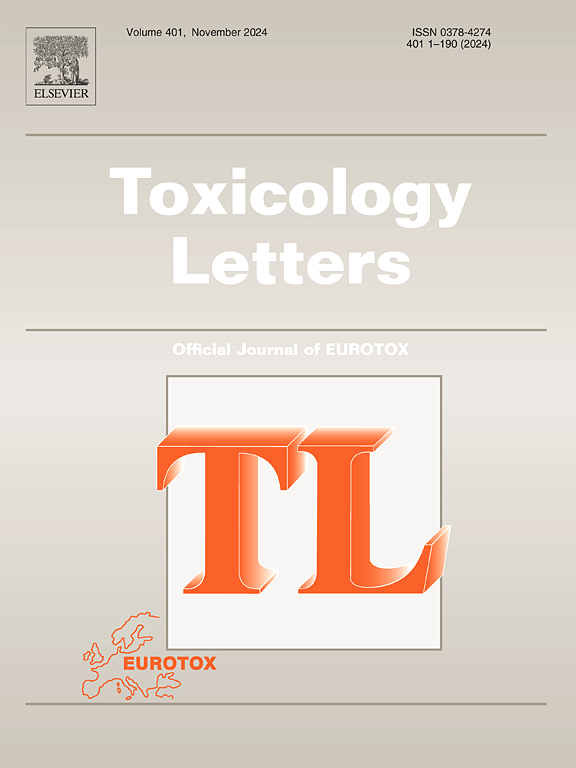Emerging nicotine analog 6-methyl nicotine increases reactive oxygen species in aerosols and cytotoxicity in human bronchial epithelial cells
IF 2.9
3区 医学
Q2 TOXICOLOGY
引用次数: 0
Abstract
Nicotine-contained e-cigarettes (E-cigs) generate reactive oxygen species (ROS), volatile organic compounds, and heavy metals. Inhalation toxicology studies suggest that exposure to these toxicants may adversely impact human health. These findings led to the U.S. Food and Drug Administration’s (FDA) regulation of nicotine-containing E-cigs under the Tobacco Regulation Act (TRA) of 2020. Manufacturers aiming to sell nicotine products in the U.S. must submit a Premarket Tobacco Product Application (PMTA) and obtain FDA approval before marketing their products. However, due to the lengthy PMTA process, some companies have exploited a loophole in the TRA (2020) by introducing nicotine analogs, such as 6-methyl nicotine (6-MN) into E-cig products. 6-MN is marketed as a ‘safer’ alternative to nicotine, offering comparable satisfaction despite not being derived from tobacco or nicotine. Nonetheless, its safety profiles are unknown. Therefore, this study tested the toxicity of 6-MN compared to traditional nicotine in vitro. We observed that thermal degradation of 6-MN in e-liquids significantly generated more ROS in the aerosols than nicotine. We investigated the dose-response cytotoxicity of 6-MN vs nicotine when exposed to HBEC3-KT human bronchial epithelial cells. 6-MN-contained e-liquids significantly increased cytotoxicity and intracellular ROS induction in a dose-specific manner compared to nicotine. Further, we observed that 6-MN (pure compound) transiently increased metabolic activity significantly at all doses tested compared to nicotine. Given the potential risks associated with 6-MN, it cannot be deemed ‘safer’ than nicotine. Therefore, further primary toxicological research is urgently needed to provide regulatory agencies with more robust data to implement regulations.
新出现的尼古丁类似物6-甲基尼古丁增加气溶胶中的活性氧和人支气管上皮细胞的细胞毒性。
含有尼古丁的电子烟会产生活性氧(ROS)、挥发性有机化合物和重金属。吸入毒理学研究表明,接触这些毒物可能对人体健康产生不利影响。这些发现促使美国食品和药物管理局(FDA)根据2020年《烟草管理法》(TRA)对含尼古丁的电子烟进行监管。打算在美国销售尼古丁产品的制造商必须提交上市前烟草产品申请(PMTA),并在销售产品之前获得FDA的批准。然而,由于PMTA过程漫长,一些公司利用了TRA(2020)的漏洞,在电子烟产品中引入尼古丁类似物,如6-甲基尼古丁(6-MN)。6-MN作为尼古丁“更安全”的替代品销售,尽管不是来自烟草或尼古丁,但也能提供类似的满足感。尽管如此,它的安全性仍是未知的。因此,本研究在体外测试了6-MN与传统尼古丁的毒性。我们观察到,电子液体中6-MN的热降解在气溶胶中产生的活性氧明显多于尼古丁。我们研究了暴露于HBEC3-KT人支气管上皮细胞时6-MN对尼古丁的剂量反应细胞毒性。与尼古丁相比,含有6- mn的电子液体以剂量特异性的方式显著增加细胞毒性和细胞内ROS诱导。此外,我们观察到,与尼古丁相比,6-MN(纯化合物)在所有测试剂量下都能短暂地显著增加代谢活性。考虑到6-MN的潜在风险,它不能被认为比尼古丁“更安全”。因此,迫切需要进一步的初级毒理学研究,为监管机构提供更可靠的数据来实施法规。
本文章由计算机程序翻译,如有差异,请以英文原文为准。
求助全文
约1分钟内获得全文
求助全文
来源期刊

Toxicology letters
医学-毒理学
CiteScore
7.10
自引率
2.90%
发文量
897
审稿时长
33 days
期刊介绍:
An international journal for the rapid publication of novel reports on a range of aspects of toxicology, especially mechanisms of toxicity.
 求助内容:
求助内容: 应助结果提醒方式:
应助结果提醒方式:


